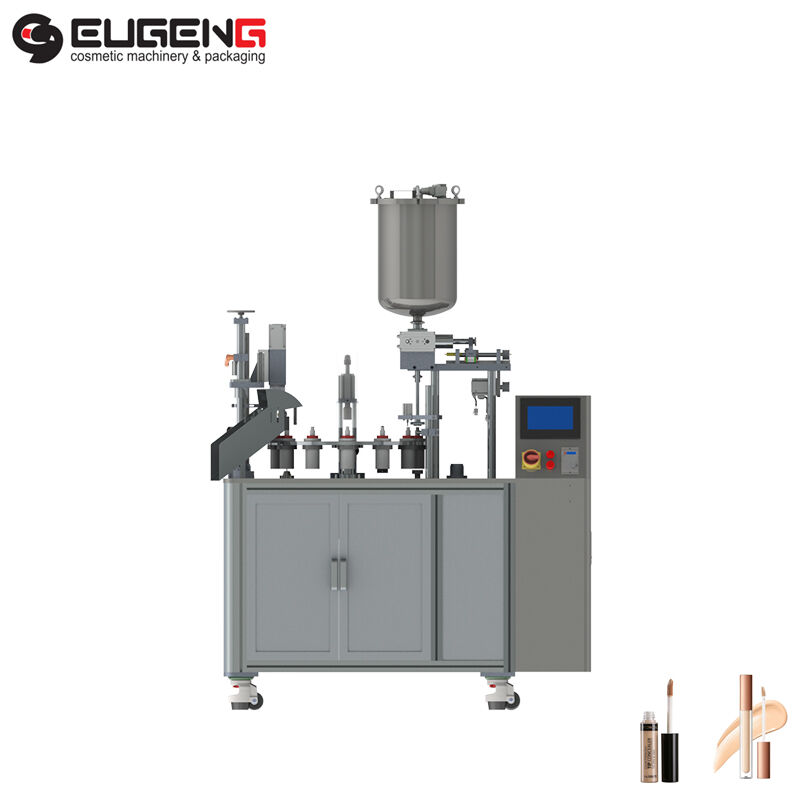Meeting Demand Through Automation
The beauty industry is witnessing an unprecedented surge in demand, particularly for color cosmetics like lip gloss. To stay competitive and meet consumer expectations, cosmetic manufacturers are rapidly turning to automation. One of the most impactful innovations is the adoption of the lip gloss filling machine, which streamlines the production process and significantly boosts output without sacrificing quality.
Core Functions of Lip Gloss Filling Equipment
Precision Filling for Viscous Formulas
Lip gloss is a thick, semi-viscous product that requires careful handling during the filling process. Automated lip gloss filling machines are engineered to handle these formulations with high accuracy. Using piston-driven or servo-controlled filling mechanisms, the machines ensure each container is filled to the correct volume, minimizing waste and eliminating inconsistencies.
Temperature-Controlled Dispensing Systems
Some lip gloss formulas need to be maintained at specific temperatures to preserve their texture and appearance. High-end machines are equipped with heated hoppers and fill lines, which keep the product in an ideal state for dispensing. This feature not only improves flow but also helps prevent clogs or hardening of the formula during the filling process.
Integrated Capping and Labeling Options
Modern lip gloss filling machines often include integrated solutions that go beyond dispensing. These systems can handle capping, labeling, and even sealing, turning a traditionally multi-step process into a seamless, automated workflow. As a result, manufacturers can reduce labor costs and increase line efficiency.
Benefits of Automating Lip Gloss Production
Consistency Across Batches
Automated filling ensures that every unit of lip gloss meets the same quality and appearance standards. This is especially important for brands that prioritize customer satisfaction and seek to maintain a uniform brand image across global markets. Machines programmed with specific fill weights and container dimensions can operate continuously with minimal error.
Faster Turnaround Times
Speed is one of the biggest advantages of using a lip gloss filling machine. Manual production is time-consuming and prone to error, but automation allows companies to produce hundreds—or even thousands—of units per hour. This speed supports quicker product launches and allows for flexible response to market trends.
Lower Operational Costs
Although the upfront investment in a filling machine may seem high, the long-term savings are substantial. Automation reduces dependency on manual labor, lowers material waste, and decreases the risk of product contamination or spillage. These factors collectively lead to a lower cost-per-unit, especially for large-scale operations.
Flexible Configurations for Diverse Product Lines
Accommodating Various Container Shapes
Whether it's traditional tubes, compact pots, or custom-designed bottles, modern filling machines offer adjustable settings that can be tailored to different container types. This flexibility makes it easier for brands to experiment with new packaging without requiring new equipment each time.
Handling a Range of Lip Gloss Types
The market includes various lip gloss formulations, such as shimmer, glitter-infused, or tinted options. A good lip gloss filling machine can handle each of these with precision. Customizable fill volumes, variable speed settings, and changeable nozzles ensure compatibility with multiple product types and viscosities.
Quick Changeover Capabilities
One of the primary challenges in multi-SKU production is downtime caused by changing over between products. Advanced machines are designed with quick-change components that minimize transition time. This allows for efficient short-run manufacturing and is ideal for brands offering seasonal or limited-edition glosses.

Improving Hygiene and Quality Assurance
Reducing Human Contact
In cosmetics production, hygiene is non-negotiable. By automating the filling process, manufacturers can reduce direct human contact with the product. This lowers the risk of contamination and aligns with global standards for cosmetic Good Manufacturing Practices (GMP).
Easy-to-Clean Construction
Lip gloss filling machines are typically constructed from stainless steel or other sanitary materials that are resistant to corrosion and easy to clean. Many models also support Clean-In-Place (CIP) functionality, enabling faster and more thorough sanitation between batches.
In-Line Quality Checks
Some machines come with built-in inspection systems that monitor fill level, capping alignment, and labeling accuracy. These features help detect issues in real-time, allowing operators to make adjustments before defective units accumulate, thereby maintaining a high standard of output.
Economic Advantages and Long-Term ROI
Scaling with Business Growth
As your brand grows, so should your production capacity. A scalable lip gloss filling machine enables you to begin with a semi-automatic setup and transition to fully automatic systems without replacing the entire line. This modular approach makes growth more manageable and cost-effective.
Enhancing Brand Credibility
Consistency and quality are cornerstones of brand trust. Automated systems ensure that every product adheres to the same specifications, reducing customer complaints and returns. Over time, this builds a more reliable brand image and fosters consumer loyalty.
Better Resource Management
Precision filling leads to less product waste, while faster production cycles improve the utilization of materials, labor, and equipment. These efficiencies translate to a better use of capital and a quicker return on investment, especially in high-demand seasons.
Future Developments in Lip Gloss Production
Smart Automation Technologies
Artificial intelligence and machine learning are beginning to influence the cosmetics manufacturing space. Next-generation lip gloss filling machines may include self-adjusting features, predictive maintenance alerts, and automated quality assessments that further reduce the need for human intervention.
Sustainable Manufacturing Solutions
With growing interest in sustainable beauty, equipment manufacturers are developing machines with energy-efficient motors, low-emission processes, and components that support eco-friendly packaging. This shift not only helps the planet but also attracts environmentally conscious consumers.
Compact Designs for Smaller Facilities
Not all cosmetic producers operate out of large factories. For boutique brands and indie manufacturers, compact, table-top lip gloss filling machines offer professional-grade performance in a smaller footprint. These machines are ideal for limited runs, niche products, or startups testing new formulations.
FAQ
What is the average output of a lip gloss filling machine?
Depending on the model and automation level, output can range from 20 to 120 units per minute. Fully automatic systems deliver the highest output, while manual and semi-automatic machines are better suited for smaller batches.
Can one machine handle both lip gloss and other cosmetic products?
Yes. Many machines are designed to be multipurpose. With appropriate configuration and cleaning, they can fill other viscous cosmetic products such as lip balm, cream-based blushes, or even mascara.
How often does a filling machine require maintenance?
Routine maintenance is typically minimal and involves cleaning the nozzles, checking the seals, and inspecting the electrical components. Some models also feature self-lubricating parts and diagnostic systems that alert you when maintenance is needed.
Is operator training required for these machines?
Yes, although most machines are user-friendly, some level of training is needed to ensure optimal performance. Suppliers often provide instructional materials, onsite training, or remote technical support to assist with setup and operation.

 EN
EN
 AR
AR BG
BG HR
HR CS
CS DA
DA NL
NL FI
FI FR
FR DE
DE EL
EL HI
HI IT
IT JA
JA KO
KO NO
NO PL
PL PT
PT RO
RO RU
RU ES
ES SV
SV TL
TL IW
IW ID
ID LV
LV LT
LT SR
SR UK
UK VI
VI HU
HU TH
TH TR
TR FA
FA MS
MS UR
UR BN
BN LO
LO LA
LA PA
PA
